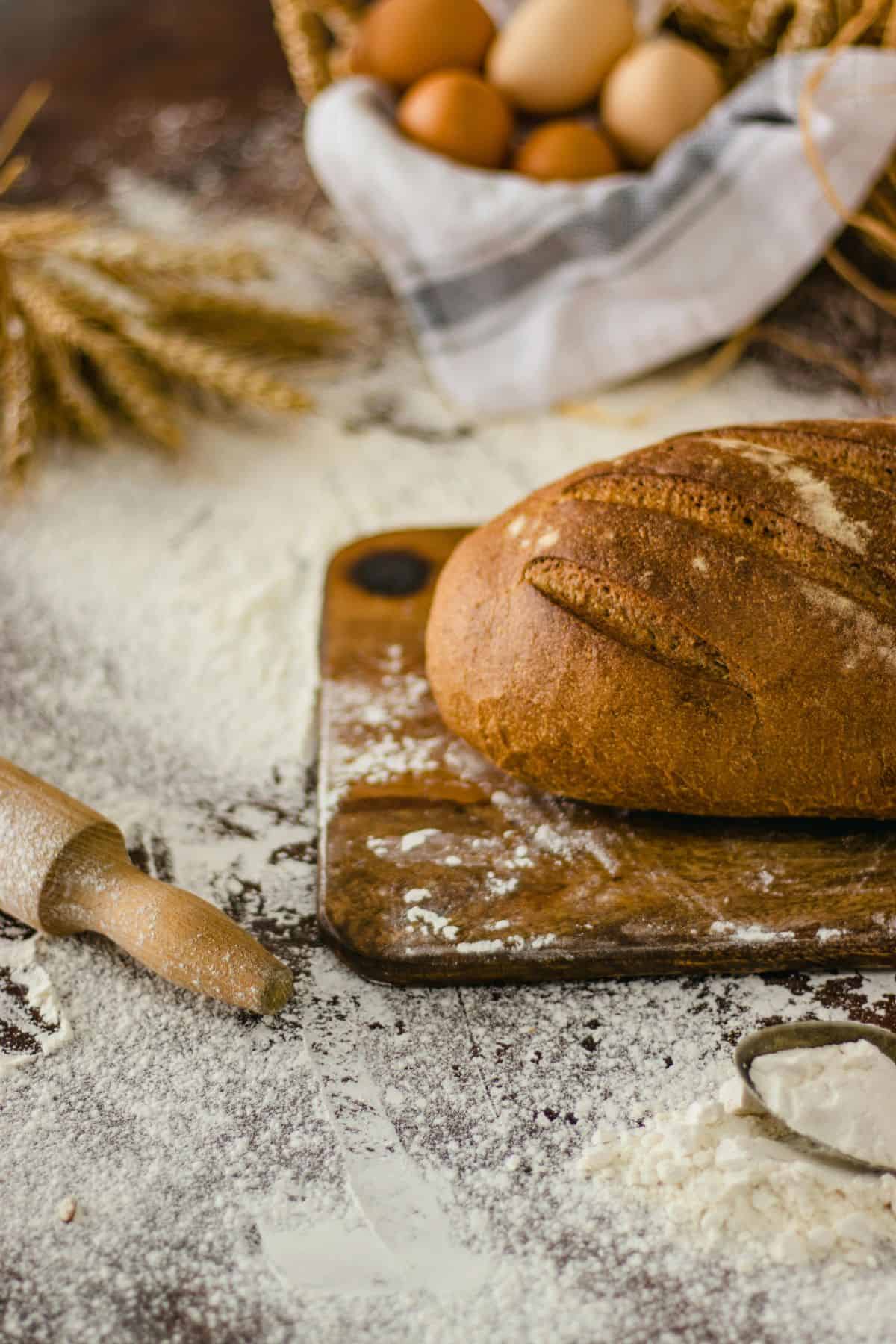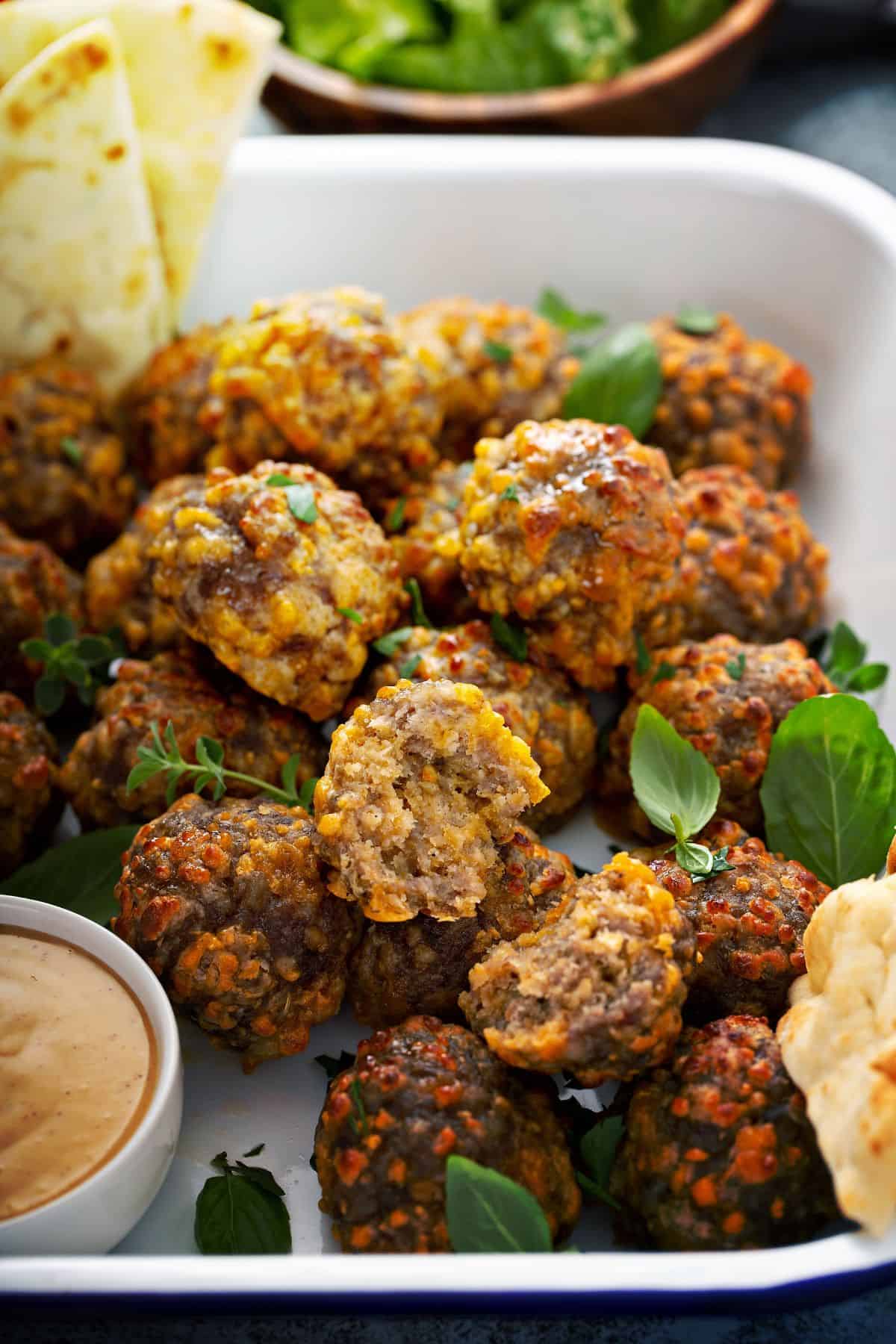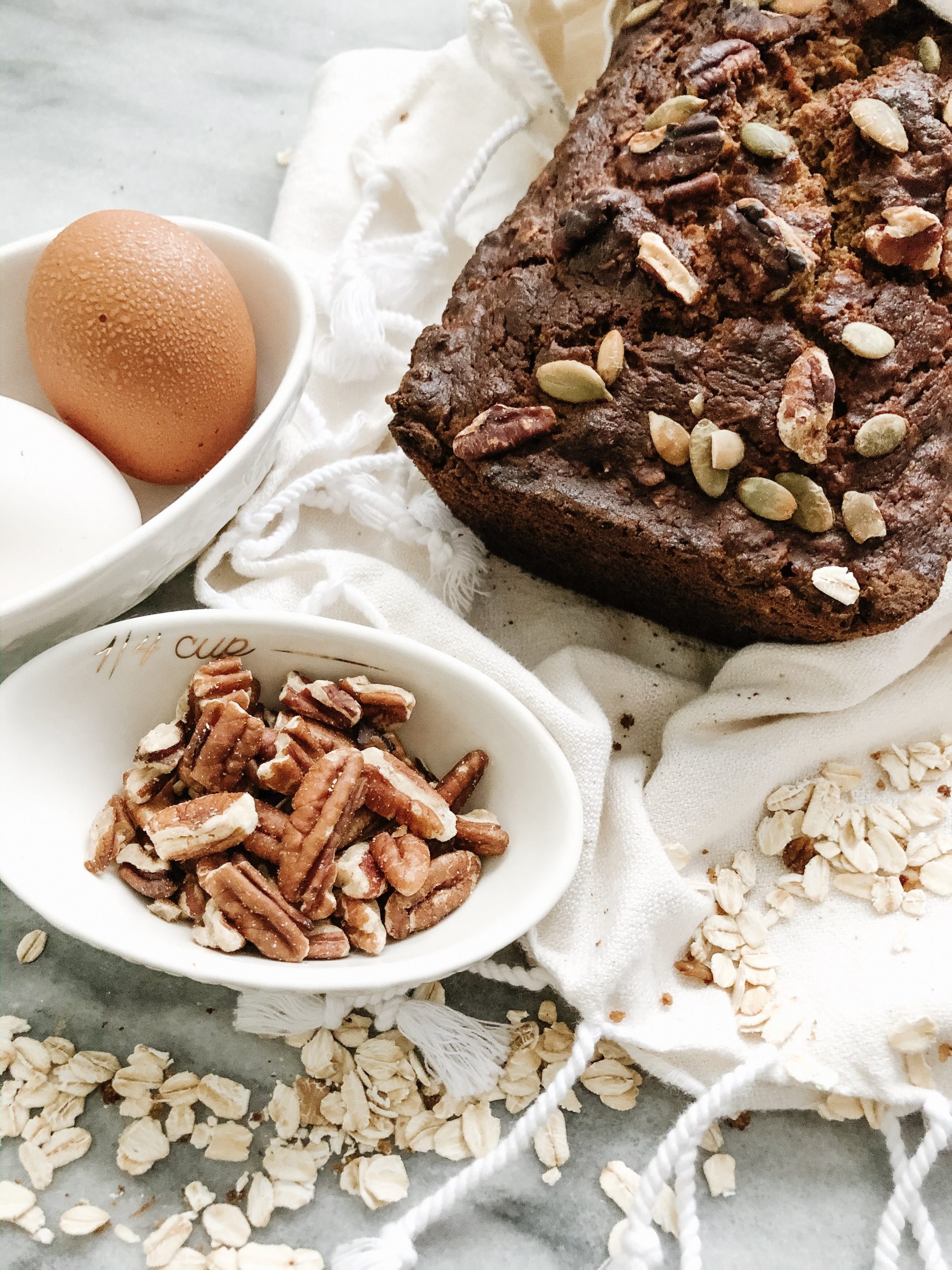Baking with Freshly Milled Flour: Your Guide to Whole Wheat
Baking with freshly milled flour is a delicious and healthy way to add nutrients to your diet! And though the process is simple, there are a few considerations when it comes to whole grain flour. If you’re wanting to make delicious homemade bread with freshly milled flour, this guide will tell you everything you need!

There’s something truly magical about baking with fresh milled wheat flour. It’s like bringing the goodness of whole grains straight from the field to your kitchen. The results are so much more flavorful and nutritious than what you get from store-bought flour! (In fact, one you make the switch, store-bought bread won’t have much flavor!)
Whether you’re baking a loaf of bread, a batch of cookies, or your favorite loaf, freshly milled flour can completely transform your baked goods. In my opinion, any way we can add a whole food to our diet is something to consider!
As a general rule, wheat that has not been ground or processed is called a wheat berry. You can make different flours from different grains and use them in different ways. This is good news. It means that you can create incredible whole wheat bread products with ingredients that are shelf stable for a long time! I use freshly milled flour for all our recipes, including overnight sourdough bagels and a lovely artisan loaf.
Fresh milled grains are a wonderful way to add nutrients to your diet, make food from scratch, store flour more easily, and even simplify your routine if you don’t want to pursue sourdough bread! (Though I have to say, my stiff starter sourdough method is really easy!)

What Is Freshly Milled Flour?
Freshly milled flour is flour that has been ground from whole grains, typically on the same day it is used. Most store-bought flours have been processed and often sit on shelves for long periods of time. Freshly milled flour is ground directly from grains like wheat, rye, spelt, einkorn, and other ancient grains. Milling it fresh preserves all the nutrients and flavor that can be lost during long storage. This offers a more wholesome baking experience!
The milling process simply grinds the grain, without removing the bran and germ. So when you grind your own flour, it retains more nutrients than buying flour from the grocery store. Whole wheat flour includes the whole grain, meaning you get all three parts of the kernel: the bran, germ, and endosperm. This gives the flour its rich texture and nutritional benefits, which is a really good thing.
Why Use Freshly Milled Flour?
Health benefits. Whole grains are packed with fiber, which aids digestion, promotes heart health, and helps maintain stable blood sugar levels. When you mill your own grains, they are rich in vitamins, minerals, and antioxidants. These include B vitamins, iron, magnesium, and zinc. Also, the fiber and prebiotics in whole grains support healthy gut bacteria, which can improve digestion and overall gut health.
Ease. Making breads from freshly milled flour is actually quite simple. The process may seem overwhelming at first, but any home baker can use fresh ground flour for their favorite recipes! Plus, whole wheat berries are more shelf stable, so they are the best way to always have flour on hand.
Taste. Homemade bread in general is worlds better than store-bought bread. When you add the layer of freshly milling your own grains, the resulting flour has an even deeper flavor.

Types Of Wheat Berries And Their Best Uses
Not all wheat berries are created equal! Depending on the type of wheat, you’ll get different textures and flavors in your baked goods. Here’s a breakdown of the most common wheat varieties, along with their best uses:
Hard wheat:
- Hard Red Wheat: This is one of the most popular wheat varieties used for bread-making. Hard red wheat has a higher protein content, which gives it excellent gluten-forming properties. It is ideal for rustic, chewy loaves and hearty breads. Its strong, slightly nutty flavor enhances the taste of sourdough, whole wheat, and multigrain breads. The higher protein content in hard wheat berries makes a huge difference in the final product.
- Hard White Wheat: Hard white is similar to hard red wheat in protein content but with a lighter, milder flavor. It is a great option for lighter bread, pizza dough, and dinner rolls. It gives a softer crumb and a more neutral color, making it ideal for those who want whole-grain goodness without the strong flavor of traditional whole wheat. This is the wheat I use in our basic bread recipe and what would be a decent substitute for bread flour.
Soft wheat:
- Soft Red Wheat: Soft red wheat flour is perfect for delicate baked goods, such as cakes, pastries, and cookies. It has a lower protein content than hard red wheat. Its finer texture and milder flavor are great for creating soft, tender crumbs in baked items that don’t require the strong gluten structure of hard red wheat. Red wheat in general has a more earthy, nutty flavor compared to white wheat.
- Soft White Wheat: This variety is great for pastries and other baked goods that require a more tender, delicate crumb. Think biscuits, muffins, and cookies! Its low protein content and smooth texture make it perfect for those softer bakes like these pumpkin spice cinnamon rolls! Soft wheat in general has a lower protein content than hard wheat. This is why it works well for baked goods. If you want to make an everyday sandwich bread with soft white wheat, you can add some vital wheat gluten to increase the protein content. I do this frequently with our sourdough recipes!
Other commonly used grains:
- Millet: Millet has a mild, nutty flavor and a slightly crunchy texture when used in baking. It is a good choice for quick breads, muffins, and crackers, and can also be used in savory dishes. It’s a great gluten-free option when combined with other flours, providing a light, airy crumb.
- Spelt: Spelt is a close relative of wheat and adds a nutty, slightly earthy flavor to your baked goods. It’s a great choice for bread, muffins, pancakes, and cookies. Spelt flour is somewhat more water-soluble than regular wheat flour. You might need to adjust hydration levels when baking with it.
- Rye: Rye flour brings a distinctive flavor to your baking. It’s perfect for classic rye bread, pumpernickel, or even in sourdough recipes, where it contributes to a tangy, hearty flavor. Rye’s lower gluten content means you may want to blend it with higher-protein wheat flours for the best results. It’s great for adding depth to sourdough or whole grain crackers.
Ancient grains:
- Einkorn: Einkorn is one of the oldest wheat varieties and has a slightly sweet, nutty flavor. It’s lower in gluten than modern wheat, which makes it easier to digest for some people. Einkorn is wonderful in breads, cookies, and cakes and can add a rustic charm to your baked goods. It is naturally lower in phytic acid, making it a popular choice for those with slight gluten sensitivities.
- Kamut: Kamut, or Khorasan wheat, is an ancient grain known for its larger kernels, rich flavor, and higher protein content. It’s excellent for making bread with a hearty texture and a slightly sweet, nutty flavor. Kamut flour is good for pasta or even pancakes and waffles for a unique twist. When it comes to bread dough, mix Kamut with hard red or white wheat as you get used to baking with freshly milled flours. We often use kamut for our homemade tortillas!


Substituting Freshly Milled Flour For All-Purpose Flour
Substituting freshly milled flour for all-purpose flour will mean you need alter the amount of flour in your recipe.
In general, 1 cup white flour is equivalent to 1&1/4 cup freshly milled soft white wheat berries (or any soft wheat).
- When using hard red or white wheat, kamut, or barley, you will need a smaller quantity of flour. These grains are low-moisture, and will not soak up as much of the water.
- When substituting pastry flour or all-purpose with soft wheat, spelt, rye, or other high-moisture grains, you will need more flour. Add small amounts at a time. In general, add 1/4 cup more flour for every 1 cup of flour in the recipe.
Tips For Baking With Freshly Milled Flour
Baking with freshly milled flour can be a bit different from using store-bought flour. Here are some tips to help you get the best results:
- Start with Half and Half: If you’re new to freshly milled flour, try mixing half freshly milled flour with half all-purpose flour the first time you bake. You will get used to the texture and taste of whole grains while still ensuring quality results in your baked goods.
- More Hydration Needed: Freshly milled hard wheat for bread tends to absorb more water than all-purpose flours. Depending on what grain you are using, you may need to add extra liquid to your dough. Start with a little more water and adjust as needed until you get the right consistency.
- Watch the Rise: Whole grain flours tend to have a heavier, denser texture. You may need to adjust your proofing times to ensure the dough has enough time to rise fully.
- Grind What You Need: When you mill flour, it is best to simply grind what you need for the fresh milled flour recipes you are making. In general, 1 cup of wheat berries equates to 1 &1/2 cup of flour. If you have some extra flour, you can store in an airtight container to use as within the next week.

Freshly Milled Flour And Sourdough Baking
Freshly milled flour can add great depth and flavor to your sourdough bread. Whole grain flours offer more nutrients for the wild yeast and bacteria in your starter. This helps the starter become more active and robust. Here are a few things to keep in mind:
- Start with Your Starter: Your starter will be the most important thing! If you’re switching to freshly milled flour for your sourdough starter, begin by feeding it with whole grain flours like hard red wheat or rye. These flours have higher nutrient content, which helps the wild yeast and bacteria in the starter grow more robustly. You don’t absolutely have to feed your starter freshly milled flour. You could feed it all-purpose flour and bake with freshly milled flour. I find that a sourdough starter with freshly milled flour does not pass the float test . Instead pay attention to the rise of the starter.
- Consider Hydration Levels: Just like with regular baking, freshly milled flour in sourdough requires more hydration. Expect to add more water than the recipe calls for. This is especially true for whole wheat or rye, which can absorb a lot of moisture.
- Mix Different Grains: If you’re looking for a complex, flavorful loaf, try combining different whole grains in your sourdough recipe. A mixture of rye, hard red wheat, and spelt can provide a rich, multi-dimensional flavor. A great place to start for an everyday bread is 25% kamut and 75% hard white wheat.
- Adjust Your Baking Time: Freshly milled flour can make dough denser, so it will require longer proofing and often, longer baking. Watch your loaf during the final rise and while in the oven to ensure it’s fully cooked.

Tools You Will Need
Grain mill: To grind your own wheat berries, you need a flour mill! I found a Fibidus on Marketplace that I love. I keep mine on the kitchen counter because we use it frequently — and because it’s lovely! Mills can get expensive, so consider second hand and shop around. Another alternative would be to find a friend who would let you grind fresh flour for a week at a time.
Whole wheat berries: I would suggest purchasing both soft wheat and hard wheat grain berries (either red or white, your preference) if you are just starting out. When it comes to purchasing your pounds of wheat berries, you would ideally have local source. If not, a co-op like Azure Standard would be another option.
Stand mixer: I find my stand mixer to be very helpful for bread making in general!
Freshly Milled Flour FAQs

Baking with freshly milled flour is a rewarding way to create healthier, more flavorful baked goods. Whether you’re making a loaf of bread, a batch of cookies, or a pizza crust, using freshly milled flour adds richness, texture, and nutritional benefits to your creations. With a little practice, you’ll be able to incorporate these whole grains into your everyday baking routine. Happy baking!





